Important Announcements and Notes
Outdated technical features are subject to removal in order to keep the CloudGen Firewall up to date and performing properly. See the following two paragraphs for the features that will be removed in this release and the features that are subject to removal in upcoming releases.
Certain features will be removed completely because they have become technically obsolete; other features have become outdated and will be replaced by improved technology.
Features No Longer Supported as of the 8.3.0/8.3.1 Release
Generic Forwarder
As of 8.3.0/8.3.1, networks that were entered in General Firewall Configuration -> Operational -> Generically Forwarded Networks are no longer supported and will be removed. Networks that are configured in this list will no longer be forwarded by the firewall after updating to release 8.3.0 or higher. You must configure a forwarding firewall service with corresponding rules to have this functionality.Protocol 254/FW compression
Firewall-to-Firewall compression has been discontinued and is no longer configurable. Traffic that was previously configured to use FW-2-FW compression will now be transported uncompressed.
Features that Will Become Obsolete in an Upcoming Release
FWAudit
WAN Optimization
CloudGen Firewall Web UI
Precautionary Security Measures for Control Centers
Important Note for Users Wanting to Upgrade from Firmware Release 8.2.2
As of February 6, 2023, you can now upgrade from firmware release 8.2.2 to firmware release 8.3.1. This upgrade can be installed both on CloudGen Firewalls and on Control Centers. However, as this is a special upgrade, there are two different methods of how you must perform it depending on the type of your appliance.
For more information on how to upgrade from firmware release 8.2.2 to 8.3.1, see 8.3.1 Migration Notes.
Use the Appropriate Firewall Admin Release
Generally, Barracuda Networks recommends using the latest version of Firewall Admin for a new firmware release.
As of the public availability of this firmware 8.3.1, Barracuda Networks recommends using at least Firewall Admin version 8.3.1-64. You can download this version here: https://dlportal.barracudanetworks.com/#/packages/5466/FirewallAdmin_8.3.1-64.exe.
Release Notes
Firmware version 8.3.1 is a minor release.
The following devices have reached EoL status:
Device Type | Model | EoL Date |
|---|---|---|
CloudGen Firewall | F800 Rev. B | 2022-03-01 |
CloudGen Firewall | F900 Rev. A | 2021-11-31 |
Control Center | C400 | 2022-02-28 |
Control Center | C610 | 2022-02-28 |
Modem | M10 (3G/UMTS) | 2019-03-31 |
Modem | M11 (3G UMTS) | 2021-09-30 |
What's New in Version 8.3.1
CGF Policy Profiles
On Barracuda CloudGen Firewall version 8.3.1, a new feature has been implemented that allows central management of SD-WAN policies as well as policies for handling different network scenarios and applications. Policy profiles are predefined rules that can be applied to access rules on Control Center-managed or stand-alone firewall units. The Barracuda CloudGen Firewall allows administrators to manage, create, and customize general policies on global, range, cluster, or box level that can then be applied to access rules instead of configuring firewall objects. You can customize default profiles by adding or modifying policies or creating new profiles with explicit policies. This new feature is specifically designed to simplify the handling of policies, especially on a global scale. For more information, see Policy Profiles.
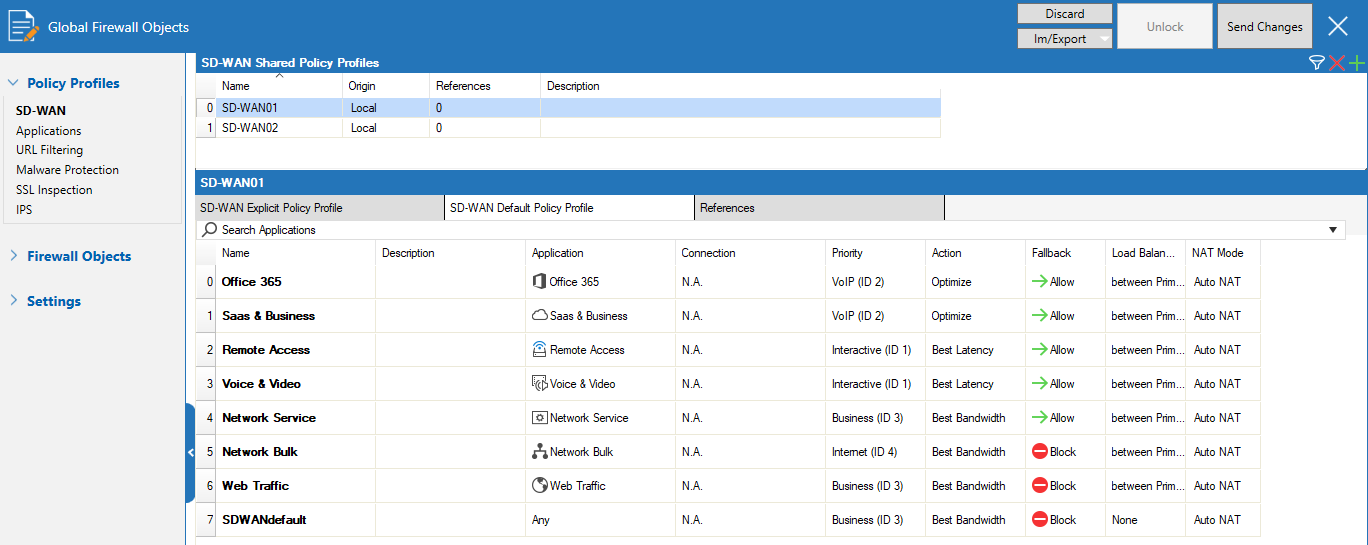
The Barracuda CloudGen Firewall provides the following policies:
SD-WAN Policies
SD-WAN provides multipath VPN tunnels across all providers with redundant, reliable, and fail-safe network connections. The Barracuda CloudGen Firewall provides a predefined default configuration of SD-WAN policies that allows you to use the advantages of SD-WAN immediately, without even having to set up your own configuration. For more information, see How to Create SD-WAN Policies.
Application Policies
Application policies allow administrators to block, allow, or customize traffic for detected applications on a global and local level. Create explicit profiles and policies on the Control Center and assign them to access rules on managed firewalls. For more information, see How to Create Application Policies.
URL Filtering Policies
Barracuda Networks provides a large database for URL filtering. The default action of a policy can be either to block all and define exceptions that are allowed or to allow all and define exceptions that are blocked. You can customize a URL filtering policy profile to match individual requirements, or you can create explicit policies. For more information, see How to Create URL Filtering Policies.
Malware Protection Policies
Malware protection offers protection against advanced malware, zero-day exploits, and targeted attacks not detected by the Intrusion Prevention System. Scanning is done according to the virus scanner configuration and, if an Advanced Threat Protection (ATP) license is present, also by the ATP engine. For more information, see How to Create Malware Protection Policies.
SSL Inspection Policies
SSL Inspection decrypts inbound and outbound SSL and TLS connections so the Barracuda CloudGen Firewall appliance can allow features, such as Malware Protection and the Intrusion Prevention System (IPS), to scan traffic that would otherwise not be visible to the firewall service. For more information, see How to Create TLS Inspection Policies.
IPS Scanning Policies
The Intrusion Prevention System (IPS) monitors local and forwarding traffic for malicious activities and provides various countermeasures to avert possible network attacks. Create explicit IPS policies to match individual network requirements. For more information, see How to Create IPS Policies.
Barracuda Firewall Admin
Barracuda Firewall Admin has undergone many changes, including those related to the new implementations listed below. The most salient improvements are as follows:
New Network Activation
Activating the network is now supported by two new dialog windows that include user-interface items displayed either statically or dynamically, depending on the context in which the window is displayed: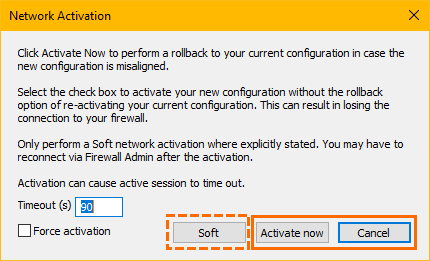
The Soft option will be displayed only in certain required contexts.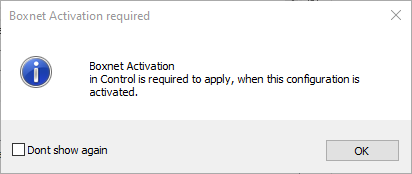
For more information, see How to Activate Network Changes.
Automated Session Reconnect
In the Control Center, the Connect button for reconnecting to a lost session has been removed. Reconnecting is now done permanently in the background. Firewall Admin checks the availability and immediately reconnects to an appliance when it becomes available after a previously lost session.
Automated HA Auto Pairing
The HA Auto-Pairing feature has been improved and now supports automated pairing of two Control Centers as well as the automated pairing of managed firewalls.
For more information, see HA Auto-Pairing and How to Enable HA Auto-Pairing for Two Managed Firewalls.
Barracuda Firewall Admin
If multiple tabs are open in Barracuda Firewall Admin and the main window will be closed by clicking the 'X' symbol in the upper right corner of the window, a dialog will be displayed giving the user the choice to cancel the closing of all tabs or to keep Firewall Admin's window open. The option of displaying the dialog window can be turned off via a checkbox.
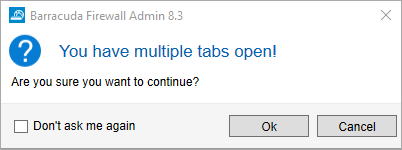
C2S TINA VPN Improvements
Unlike before, when network routes could only be entered as an IP address, they can now be entered as a domain in the group policies. These domains will be resolved by the CloudGen Firewall when a client connection to the firewall is established using Barracuda Network Access Client. In addition, a description can now be added to the domain names. This feature also is available when creating licenses for VPN users or when creating network routes for a template.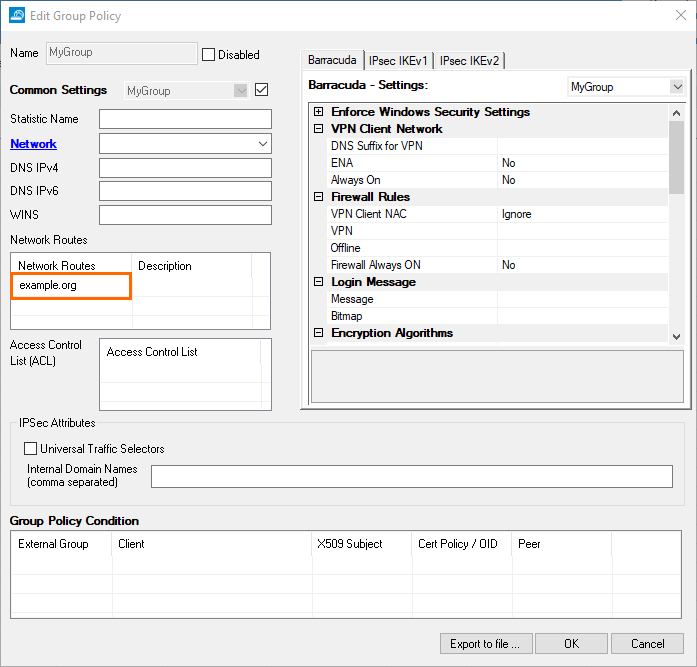
On the NAC client site, these added domains will be introduced to Windows machines as routes using their related IP addresses. In order to log the DNS calls to resolve the introduced routes, some new logs have been added to the NAC client.
In order to avoid fragmented IP packets, a new transport mode has been added to the Barracuda Network Access Client > Machine VPN Profile, tab General, Tunnel Settings > Tunnel Mode. This mode starts the authentication and authorization messaging using the TCP protocol and then switches to the UDP protocol for exchanging data streams. For more information, see How to Create VPN Profiles.
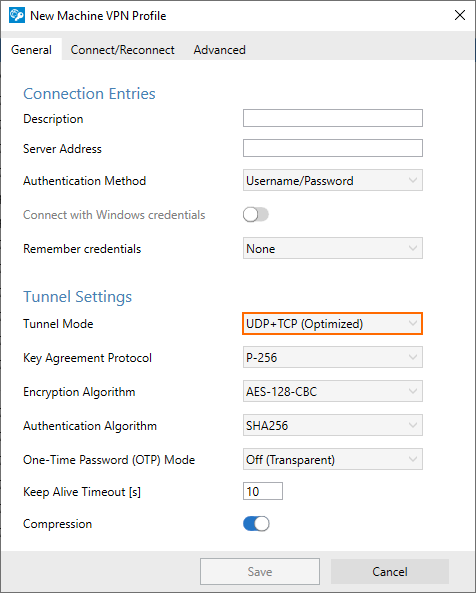
The MTU size can now be managed centrally in the VPN Settings. Unlike before, when the MTU size had to be configured individually on each client, clients will now receive the centrally managed MTU value when connecting to the VPN server.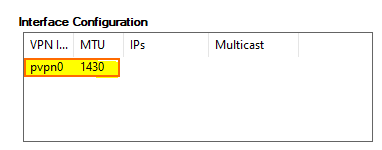
In the Barracuda encryption settings at CONFIGURATION > Configuration Tree > Box > Assigned Service > VPN Service > Client to Site-VPN, tab External CA > Barracuda, window Barracuda Settings, a check box has been added that limits connections to the VPN server only for Windows clients that have disk encryption enabled.
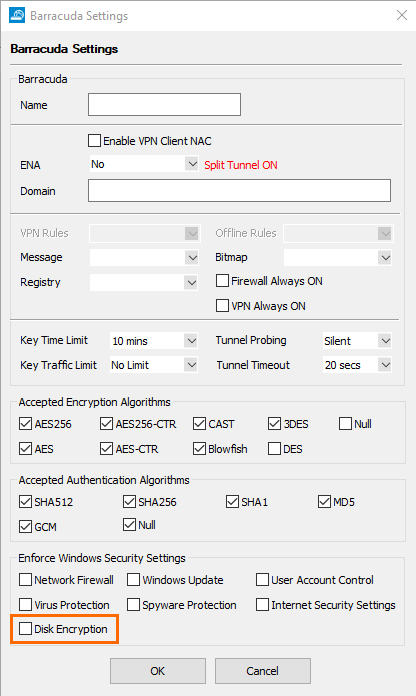
For the VPN server certificate, you can now configure a certificate chain.
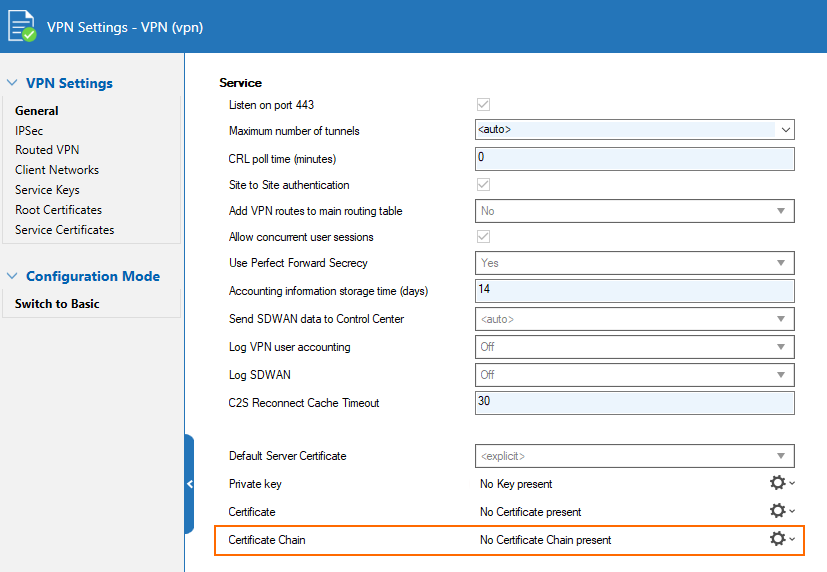
For importing a certificate or a certificate chain, a password query has been implemented that displays a dialog window in the following three cases:
When the file to be imported is encrypted.
When parsing the file is not possible, e.g., due to faulty file content.
When the file to be imported has a different file extension, e.g., 'p12', ...
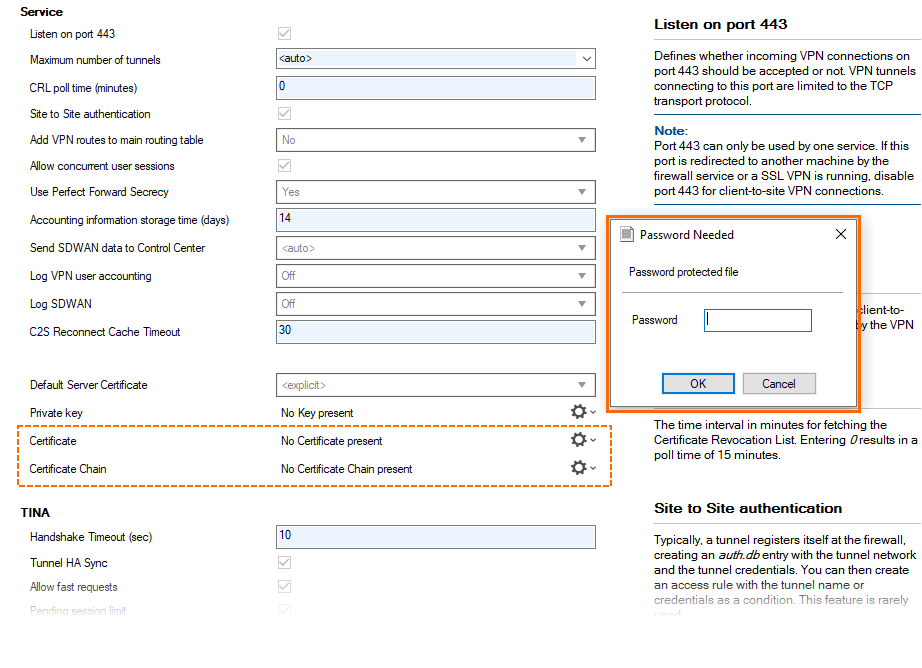
And finally, two new encryption methods, AES-GCM and AES-CTR, can now be configured in the client-to-site VPN Settings.
ConfTemplates
The ConfTemplate Editor has been improved. It now contains three areas for managing templates and instances:
Edit – Clicking Edit brings the editing area for interactively configuring the template through edit fields to the front.
Script – Clicking Script brings the script editor for configuring the template in text mode to the front and displays the ConfTemplate in the script language TDL.
Show Reference Library – Clicking Reference Library opens the window for configuring parameters and variables.
For more information on ConfTemplates, see Configuration Templates.
For more information on the ConfTemplate Manager, see Configuration Template Manager.
For more information on the TDL script language, see Template Definition Language - TDL.
ConfUnits
ConfUnits have been updated, whereby some ConfUnits have been replaced and other units have been extended. There are two groups of ConfUnits:
CGF ConfUnits currently include:
cgfCore, cgfDhcpSubnet, cgfDns, cgfFirewall, cgfGtiTunnel, cgfIpv4Route, cgfIpv6AdditionalAddress, cgfIpv6Route, cgfIpv6SharedNetwork, cgfRemoteManagementTunnel, cgfRepositoryLink, cgfSharedNetwork, cgfSiteSpecificObject.SC ConfUnits currently include:
fscAdvanced, fscConfEntry, fscContainer, fscCore, fscDhcpAdvanced, fscFirewall, fscLan, fscVpn, fscWan, fscWifi, fscWwan.
IPS
As of firmware 8.3, the CloudGen Firewall includes a new IPS system. The replacement of the former IPS system with the new implementation is fully transparent to the user. Any differences will appear at unobtrusive locations in the user interface when configuring the IPS system.
The new IPS system will operate using new IPS signatures. For this reason, the signature IDs (which are synonymous with the IPS rule sets) of the former IPS system (prior to firmware release 8.3.0) are no longer valid and will be dropped when updating to firmware release 8.3.x. For more information, see also 8.3.1 Migration Notes .
The signature database contains two rule sets:
Performance Optimized
Coverage Optimized
These two rule sets are essentially the same; however, the Performance Optimized rule set only contains signatures with priority "Critical" and "High".
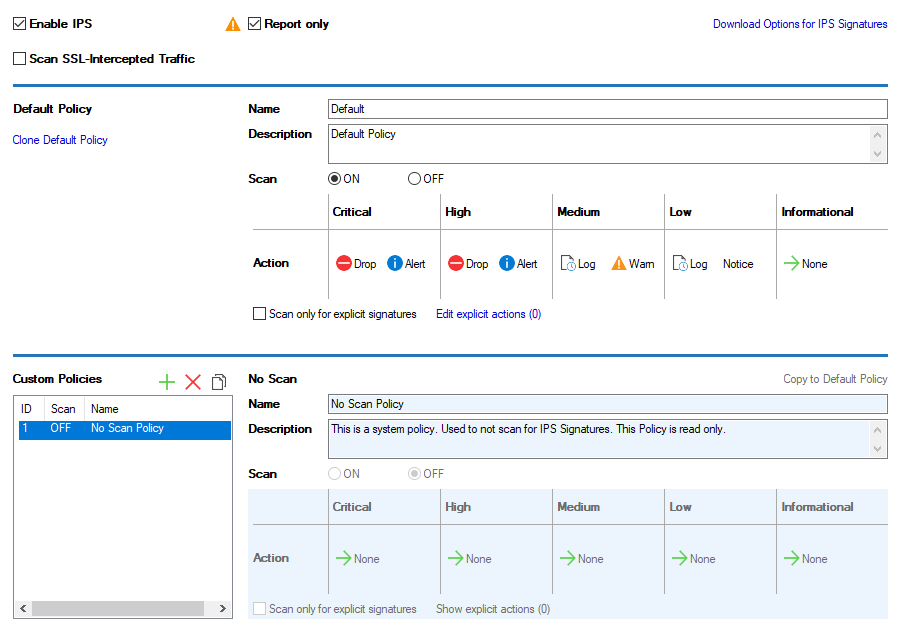
Details on the operation of the IPS in case problems arise can be inspected in the log file box_Firewall.log.
IPv6 Enhancements
In order to fully support firewalling for IPv6 addresses, the range of functions was ported from IPv4 to IPv6 on the CloudGen Firewall. All configuration options - except IPv6 WINS, which has no relevance to IPv6 - are covered in the user interface in Firewall Admin, where applicable, and can be used transparently as with IPv4.
There are certain features that do not yet work for IPv6 and will be addressed in the upcoming firmware release:
Functionality related to authentication, e.g., user matching in IPv6 rules, IPv6 address/port-based authentication, ATP quarantine.
ProxyARP-like functionality for IPv6, e.g., neighbor discovery proxy.
Application-based provider selection.
Multicast firewall rules.
Source-based routing.
Certain services do not yet fully support IPv6, e.g., HTTP-proxy, DHCP, NTP, IPFIX, SIP-proxy, and more.
Application Rules: while there are still two separate access rule sets for IPv4 and IPv6, there is only one application rule set that covers both IPv4 and IPv6 addresses. This means that application rules can match both IP versions, depending on the rule's source and destination.
OpenSSL 3 Update - FIPS
Because OpenSSL 1.0 is no longer supported, it has been replaced by OpenSSL 3. OpenSSL 3 supports running FIPS and non-FIPS sessions simultaneously but can also operate in only FIPS or non-FIPS mode. OpenSSL 3 is fully transparent to the user.
With the update of OpenSSH to version 8.8 in CGF firmware 8.3.1, RSA signatures using SHA1 have been disabled by default. When using an up-to-date client, this should not be an issue because it will automatically use another hashing algorithm. However, when using older clients, SSH logins might suddenly no longer work after the update. If this happens, it is recommended to first try with Firewall Admin and, if that still works, to check if updates to the SSH client being used are available.
REST API
The REST API has been updated and now includes the latest implementations.
The endpoints referencing an explicit virtual server were marked as deprecated in 8.2.0 and have been removed in the 8.3.0 release. Using deprecated endpoint messages are logged in the restd log file. The new service container API can be used with /rest/control/v1/service-container/...
You can now configure policies used by firewall rules via REST.
Configuration endpoints are now available:
CC - create new managed box (with or without ConfTemplate)
/rest/cc/v1/ranges/{range}/clusters/{cluster}/boxesCC - Site-specific objects
/rest/cc/v1/config/ranges/{range}/clusters/{cluster}/boxes/{box}/service-container/{service}/site-specific-objects/{name}CC - Repository Links
/rest/cc/v1/config/ranges/{range}/clusters/{cluster}/boxes/{box}/repository/linkCC - Remote Management Tunnel
/rest/cc/v1/config/ranges/{range}/clusters/{cluster}/boxes/{box}/network/management-tunnelCC/Box - Authentication - Local/LDAP
CC/Box - Create/Update/Remove Service
/rest/cc/v1/ranges/{range}/clusters/{cluster}/boxes/{box}/service-container/rest/config/v1/service-container
CC/Box - IPv4/IPv6 Route Config
/rest/cc/v1/config/ranges/{range}/clusters/{cluster}/boxes/{box}/network/route/v4/rest/cc/v1/config/ranges/{range}/clusters/{cluster}/boxes/{box}/network/route/v6
For more information, see https://campus.barracuda.com/product/cloudgenfirewall/api.
VPN IKEv2
The VPN settings now contain a new configuration setting called IKEv2 Suppress Network Change Events. When the check box for this parameter is selected, network/interface changes that may cause an automatic reconnect of the VPN tunnel will be ignored. For more information, see IPsec Settings.
VPN Port Number
As of firmware release 8.3.1, the port number for the VPN server can now be configured individually in CONFIGURATION > Configuration Tree > your box > Assigned Services > VPN > VPN Settings, edit field Local VPN listen port.

Improvements Included in Version 8.3.1
Appliances
The LCD now works as expected on the F1000B. [BNNGF-83659]
Authentication
SAML authentication metadata is now generated correctly for a managed box. [BNNGF-76521]
RADIUS no longer gets spammed with authentication requests when C2S/NAC has UDP chosen as transport. [BNNGF-80365]
When group caching is enabled, authentication now works as expected. [BNNGF-81127]
Barracuda Firewall Admin
The length of the service name has been increased to 40 characters. [BNNGF-79461]
The port number for a VPN server is no longer bound to port 691 and can now be configured individually both for UDP and TCP. [BNNGF-79836]
Tabs in the ribbon bar now also display the name of the firewall and its associated MIP. [BNNGF-79931]
If multiple tabs are present in the ribbon bar, clicking on the 'X' symbol of Firewall Admin's window in the upper-right corner causes a dialog window to be displayed that must be confirmed by the user. [BNNGF-80811]
If a connection is made to an external VPN server in GTI, the transport source-IP can now be chosen in the user interface, as expected. [BNNGF-81074]
In order to avoid interrupting the loading of extremely large numbers of boxes in a Control Center, refreshing session tabs can now be disabled with the Refresh Always button on the CONTROL > Sessions page. [BNNGF-81213]
Limiting traffic in the default shaping tree now works as expected when a PC is located in the US. [BNNGF-81245]
When enabling or disabling tunnels directly in the balloon dialog window of the GTI editor, the Send Changes button is now activated as expected. [BNNGF-82276]
The list for additional VPN transport networks no longer displays additional GTI networks. [BNNGF-82939]
Cluster names are now displayed as expected in a Control Center on the CONTROL > Status Map > All page. [BNNGF-82989]
Connecting to the SSH now works as expected when connecting to the configuration with a public key and without entering the username into the AltName field. [BNNGF-83119]
When using IPsec settings for client-to-site configurations, Firewall Admin no longer crashes in certain situations. [BNNGF-83373]
The option Transform virtual server into assigned service node is now displayed as expected when clicking the appropriate configuration tree node. [BNNGF-83492]
Barracuda OS
Connection failover for UDP and ESP traffic has been improved. [BNNGF-76131]
Switching to the 'dedicated HA config mode' no longer causes network errors depending on the configuration order of the primary and secondary box. [BNNGF-77407]
The Model label on the CONTROL > Services page is now displayed as expected. [BNNGF-78300]
When SCADA detection is enabled and PLC is accessed via client-to-site VPN, the connection to PLC S7 now works as expected. [BNNGF-79273]
In rare cases, calculations caused blocked sessions that now no longer occur. [BNNGF-80007]
Application Control for AnyDesk now works as expected. [BNNGF-80329]
TLS Inspection now works as expected in the HTTP proxy. [BNNGF-80500]
Host routes with MTU 1500 now work as expected on interfaces with MTU 9000. [BNNGF-80501]
Block pages are now also injected into plaintext HTTP sessions that are routed between VRF instances. [BNNGF-81198]
The handling of IPv6 routes that are obtained through SLAAC has been improved. [BNNGF-81574]
RIP now works as expected. [BNNGF-81977]
The server node is now correctly removed from the configuration tree after migrating the old 3-layer service architecture to the new 2-layer one. [BNNGF-82070]
An update of the Firewall Insight license now works as expected if the license name was previously changed. [BNNGF-82088]
Fan speeds are now displayed correctly. [BNNGF-82702]
Security measures have been taken for CVE-2022-0847. [BNNGF-82852]
Connection Objects that reference a Single IP Network Object can now be configured again. [BNNGF-82977]
Security measures have been taken for CVE-2022-0778. [BNNGF-83054]
Connection Objects are applied as expected when using network interfaces. [BNNGF-83146]
Cloud Azure
A managed box now connects to an Azure VWAN as expected. [BNNGF-80901]
Service IPs of additional IPs are now used in an HA pair as expected. [BNNGF-81951]
Azure Load Balancer probes are now handled properly. [BNNGF-82114]
Control Center
On an 8.2.0 Control Center, the update package for 8.x to 8.2.0 now appears as expected. [BNNGF-77667]
Control Centers with IPv4 and IPv6 enabled now work as expected after an update. [BNNGF-79934]
After configuration changes, a bogus "defaultbox" is no longer displayed in the CC status map. [BNNGF-81019]
DHCP
BOOTREPLY messages are now processed as expected after the DHCP relay service is restarted following a complete configuration update. [BNNGF-81966]
DNS
If multiple DNS services are configured, DNS no longer causes issues with using incorrect source-IP addresses. [BNNGF-78289]
The TTL value for DNS is now updated as expected. [BNNGF-82180]
The DNS system BIND has been updated to version 9.16.27. [BNNGF-83078]
Firewall
The firewall no longer freezes when using IPS for UDP. [BNNGF-83189]
HTTP Proxy
The HTTP proxy no longer experiences memory leaks in certain situations. [BNNGF-80387]
The proxy service no longer causes segmentation faults after transforming a box to operate the new 2-layer service architecture (Assigned Services). [BNNGF-83509]
REST
CC Admins with ACL no longer get 403 errors on certain REST API paths in certain situations. [BNNGF-80340]
VPN
Using special characters in the Group Pattern field of the Group Policy Condition no longer causes an issue when logging in. [BNNGF-76804]
The port number for a VPN server is no longer bound to port 691 and can now be configured individually both for UDP and TCP. [BNNGF-79836]
Downloading the CRL file now works as expected. [BNNGF-80823]
IKEv2 memory leaks no longer occur when establishing VPN tunnels/transports. [BNNGF-81077]
Default route and DNS server (IKEv1 C2S with IOS 15.2) now work as expected. [BNNGF-81513]
Bandwidth probing for SD-WAN now displays the effective throughput between the two endpoints of the connection. [BNNGF-82160]
TCP traffic on WanOPT tunnels is now forwarded as expected. [BNNGF-82256]
Creating VPN connections using L2TP now works as expected. [BNNGF-82346]
Known Issues
Known Issues Related to CGF Policy Profiles
IMPORTANT – Policy profiles cannot be used on a VPN concentrator or Secure Access Controller!
Firewall – If a VPN TINA tunnel transport over a specific ISP goes down, the Internet traffic over the same ISP link will not work either. [BNNGF-81749]
Provider class in boxnet must not be changed "afterwards", unless existing VPN tunnels are reconfigured accordingly.
There is currently no VRF support for policies in 8.3.1.
Known Issues Related to Other Topics
Azure – OMS is currently not supported on CC-managed boxes.
Currently, no RCS information is logged for Named Networks. [BNNGF-47097]
Barracuda Firewall Admin – FW Admin 8.x fails to configure DNS 7.x correctly. [BNNGF-77636]
The learn-only mode for OSPF is not working as expected. [BNNGF-65299]
Barracuda OS – The IPMI log shows errors after updating the IPMI firmware to 1911-R4-3.2.5.ima. However, these error log entries do not affect the normal function of the IPMI. [BNNGF-88127]
Firewall – Inspecting traffic for QUIC / UDP 443 is currently not supported. [BNNGF-74540]
Firewall – SSL inspection breaks on office 365 admin page with TLS 1.3. [BNNGF-83026]
NOTE: If a contacted server does not support at least the configured minimum TLS version, then no connections to that server will be possible. Connections will be reset. This can especially have an impact on embedded frames or Cross-Origin Resource Sharing (CORS) when those servers do not support the same TLS version as the main site.
For troubleshooting:
Turn Box > Infrastructure Services > General Firewall Configuration > Advanced Log Settings > SSL/TLS loglevel to debug.
Look out for "alert protocol version" in SSL logs (Assigned Services > NGFW > SSL), e.g.:11.04.2022 15:36:46 Info firewall: [TAP3Worker] Worker 1: Session 1271: SSL handshake to server failed: ID 2400 192.168.100.95:54525 <=> 104.103.84.247:443 assets.onestore.ms: error in OpenSSL library: error:0A00042E:SSL routines::tlsv1 alert protocol versionFirewall Live - The device filter Any Interface does not work. [BNNGF-85689]
VPN (SCA) – With a fresh installation of 8.3.1 the SC Networks are no longer introduced into VPN table 5. [BNNGF-84737]
